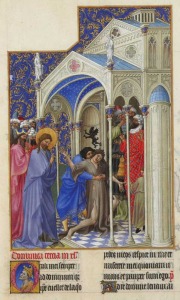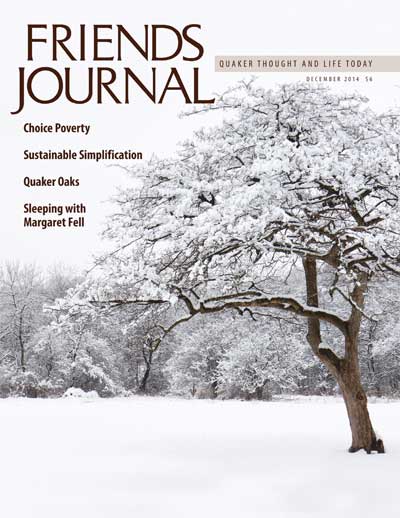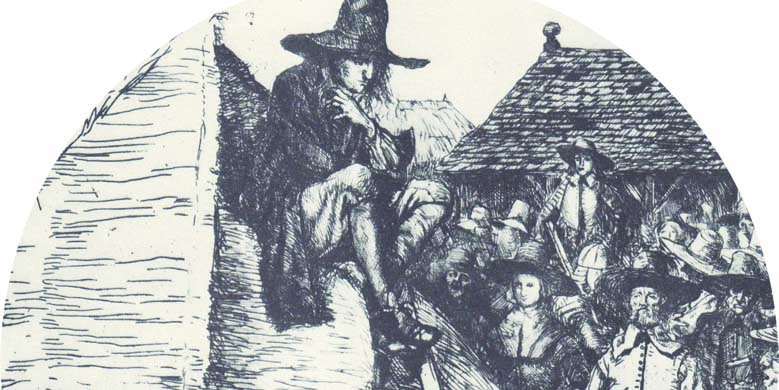
Scholars have suggested that Mark’s Gospel was written in the 60s C.E., before the destruction of the Jerusalem temple in 70 C.E., 15 to 20 years before Matthew and Luke were written, and 25 to 30 years before John. Along with Paul’s letters, this would make Mark one of the earliest of the writings of the primitive church.
Perhaps early Friends, such as Robert Barclay in An Apology for the True Christian Divinity, paid less attention to the Gospel of Mark because they saw its stories in the other more developed gospels. Mark’s writings were often severely edited by later gospel writers, and the differences between Mark and later gospels present contrasting visions of the emerging church. Mark’s writing emphasizes relation, conversation, and participation with Jesus, whereas later gospels project an admonitory tone. Thus, Mark’s Gospel may inspire faith-based activism among Friends today.
In this article, I am focusing on a couple of stories that illustrate a “Quakerliness” in Mark: the woman with a hemorrhage and Jairus’s daughter (5:21–43) and the epileptic boy (9:14–29). There are many other stories in Mark, however, that also illustrate a Quakerly Jesus: healing a paralytic (2:1–12), stilling the tempest (4:35–41), the Gerasene Demoniac (5:1–20), feeding the 5,000 (6:30–46), the Syrophoenician woman (7:24–30), the deaf and dumb man (7:31–37), and the greatest commandment (12:28–34).
In Mark, Jesus is a remarkable man who may appear irritable and stern with people but is always compassionate in his actions toward them. Mark goes out of his way to show how much people appreciated Jesus. Here is a human Jesus, most often addressed as “teacher” or “master,” in contrast with Matthew’s “Lord” or John’s divine being. There is no claim to or recognition of Jesus-as-Messiah. The Resurrection is not depicted, nor is it presupposed that the temple is destroyed. The original gospel ends dramatically on an enigmatic and terrifying note: “and the women came out and ran away from the tomb because they were frightened out of their wits; and they said nothing to anyone, for they were afraid” (16:8).
 The earliest Christians, as revealed in Mark, saw Jesus as a wonder-worker and healer of both mental and physical afflictions and as one who saw that of God in all persons, regardless of their social, demographic, or ethnic identities. Jesus had women disciples in significant numbers (also intimated in Luke 8:1–3) and saw no difference between men’s and women’s spiritual needs. Women are often portrayed as having stronger natural faith than men, suggesting the legitimacy of women discipleship in the primitive church.
The earliest Christians, as revealed in Mark, saw Jesus as a wonder-worker and healer of both mental and physical afflictions and as one who saw that of God in all persons, regardless of their social, demographic, or ethnic identities. Jesus had women disciples in significant numbers (also intimated in Luke 8:1–3) and saw no difference between men’s and women’s spiritual needs. Women are often portrayed as having stronger natural faith than men, suggesting the legitimacy of women discipleship in the primitive church.
The woman with a hemorrhage and Jairus’s daughter (Mark 5:21–43) is one such story, linking together two females with a Semitic device of the number 12. Both females are outcasts in a sense. The woman has been stricken by a bleeding disorder for 12 years and is forbidden by Hebraic law to appear in society until she is healed, and the sick girl, Jairus’s daughter, is 12 years old, a female in a male-dominated culture.

The woman has done everything possible to effect a cure, but in this story she shows courage and perseverance by doing the unthinkable. She not only goes out in public, but touches the hem of Jesus’s gown as he passes, surrounded by a crowd of curiosity seekers rushing to Jairus’s house. She somehow knows that if she does this, she will be made well again, and she is! Jesus senses her touch and stops—not to scold her for breaking the law, not to heal her (her faith has done that), but to acknowledge her trust. In the meantime, word arrives that Jairus’s daughter has died, but Jesus tells the father to have faith—like the woman who, however, needed no coaching. Eventually the daughter is raised to life by Jesus who has uttered the Aramaic words, “Talitha kum,” meaning “Little girl, I say to you, get up!” The girl gets up and begins to walk around. Are women being encouraged to “get up and walk around,” be active in ministry? The Mary/Martha narratives in Luke (10:38–42) and John (12:1–8) lend support to this supposition.
There is a final verse to Mark’s story: Jesus admonishes the parents to tell no one about the cure—characteristic of Mark’s Jesus—and then says something deceptively prosaic: “and give her something to eat.” Is Jesus suggesting that the real miracle is not what Jesus has done, so much as the quotidian love the parents have lavished on the girl, here symbolically represented by food?
In proportion to their respective lengths, twice as much attention is devoted to exorcisms in Mark than in either Matthew or Luke; there are no exorcisms in John. Mark’s Jesus begins his ministry by casting out a demon in the middle of a synagogue service (1:21–28)! Not surprisingly, some of Mark’s texts that were later the most edited have mental illness in their content: the Syrophoenician woman (7:24–30), the Gerasene demoniac (5:1–20), and the epileptic boy (9:14–29). Evidently one of the criticisms leveled at the Christian-Jews by the chief priests, elders, and scribes of the established faith was that Christians were in league with the devil, shown by Jesus’s ability to converse with demons (3:22–30). Perhaps the editing of later gospel communities reflected the desire to appear more respectable and therefore played down stories that could be misconstrued as “dark arts.”
The story of the epileptic boy (9:14–29) demonstrates that Jesus did not shy away from terrible mental afflictions, and it also illustrates something I have found striking about Mark’s Gospel: it presents Jesus acting in relation with others rather than just admonishing them. In Matthew’s version of this story, where faith is emphasized (“If you have faith the size of a mustard seed you can move mountains”), the disciples are berated for their lack of faith, and thus their inability to cure the boy. In contrast, at the center of Mark’s story is relationship. Most of the text is dedicated to a conversation of Jesus with the father of the afflicted boy, the terrible disease depicted four times in detail during the course of their conversation. What ails the boy would be “possession” in Jesus’s day, and he tells the father that if you have faith you can do anything. The father then cries out, “I have faith. Help my faith!” After the cure of the epileptic boy, Jesus is alone with his disciples, who ask him, “Why could we not cure the boy?” He answers enigmatically, “This is the kind that can be driven out only by prayer.” Instead of bawling the disciples out, he simply reminds them that it isn’t them who heal; it is God.
Although the earlier Gospel of Mark is more about Jesus’s relating to others than admonishing them, as occurs in later gospels, this article is not intended as a criticism of the later gospels. It is rather an exploration of changes in the Christian movement at a critical time. Even the late Gospel of John can be more faithful to Mark in length and content, than is Matthew or Luke, especially with regard to feminine leadership (John 4:1–53). I encourage Friends to explore this remarkable gospel further and find other gems of the early church embedded there. Christians would henceforward emphasize belief in Jesus the Messiah to attest to their legitimacy. Is this when belief as creed began to be valued more than other important aspects of faith, namely the trust and obedience so poignantly portrayed in Mark? Mark can teach us about aspects of early Christianity that were subsequently downplayed, only to emerge repeatedly in reform movements throughout history, as they did among the seventeenth-century people disparagingly called Quakers.
This version has been slightly edited from the printed magazine text, to include additional examples and citations from the author.




Comments on Friendsjournal.org may be used in the Forum of the print magazine and may be edited for length and clarity.